Plastic has been part of our lives for the past 70 years. For the sake of history, in 1953, high-density polyethylene (HDPE) brought expansion to low-density radical polyethylene (LDPE), used for rigid products such as bottles, automotive, etc. Low-density PE is used for producing flexible items like bags, films, sachets, and flexible tubes. Simultaneously, polycarbonate (PC) made its debut, representing an exceptionally transparent plastic highly resistant material in 1969. The subsequent year marked the invention of polypropylene (PP).
Considered a materials marvel, plastic has since been applied to a wide range of applications including aerospace, construction, fishing, agriculture, medical, and packaging to name a few. The most prevalent usage of plastic in our everyday lives is for the convenience of single-use disposable products. According to recent figures, over 18 trillion pounds have been produced so far with no end in sight. Unfortunately, only 9 percent of plastic has been recycled with most ending up in landfills and waterways including oceans.
Our oceans are under attack with a staggering 33 billion pounds of plastic waste added every year, according to Oceana.org. What is even more concerning is the increase of published reports on the negative effects of microplastics, now defined as nano-plastics, on the environment and wildlife, and including humans. What can we do as a society, governments, and industry to address this global crisis?
To accelerate technical innovation pathways, industry needs to partner in a collaborative manner, which I call coopetition!
The Single Use Plastics Directive1 in Europe was a wakeup call to many and prompted a high degree of industry response including lofty sustainability goals. There has been a lot of discussion and debate on the definition of plastic and, as a result, we are all closely monitoring the outcome of the United Nations Plastics Treaty2, where 175 nations agreed to develop a legally binding agreement on plastic pollution by 2024, prompting a major step towards reducing greenhouse gas emissions from plastic production, use and disposal.
How will plastic be defined outside of Europe? One thing is for sure, it will be difficult to regulate industries to an encompassing effective solution. From a technical perspective, no silver bullet or a long-term solution has been identified. The current ‘best solution’ starts with us, as consumers, utilizing the proper disposal of plastics through recycling. Yet, to accelerate technical innovation pathways, industry needs to partner in a collaborative manner, which I call coopetition!
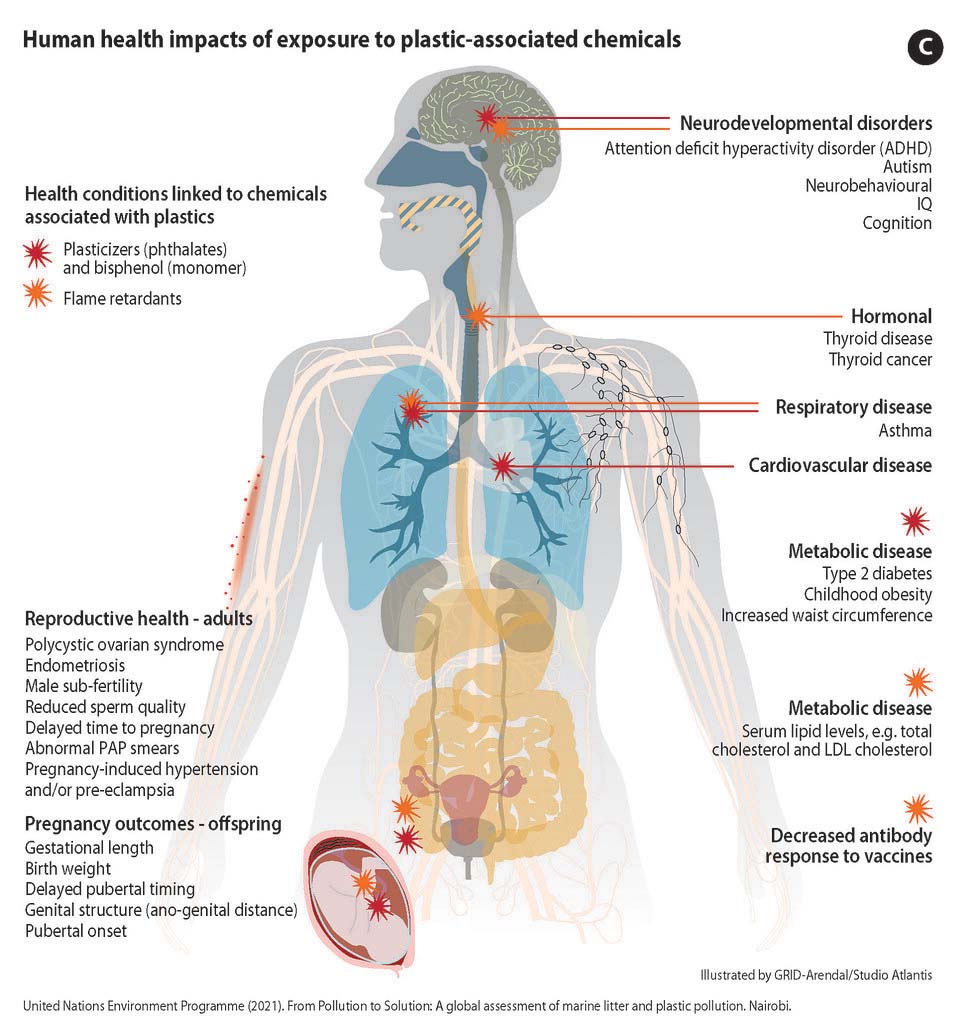
Awareness, If You Look You Will See It Everywhere
I constantly inform my family and close friends about the plastics issue. It amazes me how the average person knows so little about the issue. During a recent vacation to St. Lucia, my wife and I snorkeled at the beautiful Marigot Bay on the seaside of the island. I dove down about 15 feet to the sea floor and plastic trash could be found everywhere including bottle caps, candy wrappers, forks, fishing line, PVC pipe, and a lot of visible smaller fragments.
These smaller plastic particles look like food to many small creatures including turtles and fish; this is how plastic gets into the food chain. Unfortunately, these particles also kill animals including smaller turtles by blocking the digestion system3.
I brought up some of the trash to show the other people on the cruise. I went into some details on the hidden dangers of microplastics and how this trash is impacting wildlife including humans. I could tell a few of them were shocked and unaware of this issue. Perhaps in the future, they will all be more mindful how they dispose of plastic trash.
Real Dangers with Plastics Are What We Can’t See
If the previous images are not disturbing enough, consider the trillions of particles we can’t see. Dr. Branson Ritchie from the University of Georgia coined the term “plasticosis4” for plastics-related health issues caused by these microplastics. The term nanoplastics is now being used, because the particles that are being discovered are getting even smaller.
The negative effects of plastics on wildlife are vast, but making more recent news is the growing concern about the impacts on human health. Unfortunately, there are more studies being published that validate the concerns on the negative impact on human health. A recent study out of Italy reported that micro-plastics were found in human placentas5. More recently, micro-plastics were also found in plaques in heart patients6. Some plastics additives are being connected to certain types of cancers7.
My concern is the more we look the more we will find, where there is smoke there is fire! The case of evidence is mounting that plastic pollution poses a severe risk to human health – and that of other living creatures – and is also a contributing factor for the issue of global warming8. We can debate on global temperature changes, amounts of ice as melted, ongoing severity of storms, etc., however there is no debate on the images of pollution caused by the disposal of plastic.
Europe Has Had Enough
The European Union was first to address the plastics issue with passage of the Single Use Plastics Directive (SUPD). The passing of this legislation serves as a significant wake up call to all industries that utilize plastics in manufacturing. It has prompted numerous academic debates on solution pathways and the definition of plastic, including what is natural and not chemically modified.
Like many companies around the world, Kimberly-Clark has developed a wide-arching sustainability strategy9 for the company and its suppliers, that includes aggressive goals to be met by 2030.
Our “Better Care for a Better World” strategy sets a goal that supports our 50% plastic footprint reduction10.
There are several innovation pathways to address the plastics issue, including minimizing dependency on petroleum-based resins via plant-based resins like PLA and PHA. Unfortunately, these two potential solutions are still considered plastic due to its current definition. It is this author’s opinion that a more important characteristic of a material is its end-of-life properties, not solely how it is produced. The only caveat on production is to ensure the Life Cycle Analysis is within acceptable standards, and there are no unintended negative environmental consequences.
“Plastic Free” is a major claim companies would like to use to market their environmentally friendly products. Yet, the SUPD definition of plastic limits “plastic free” to natural fibers, rayon and lyocell. There is hope that when the SUPD is re-examined in 2026 there will be modification to the plastic definition to be more inclusive for potential solution pathways that are based more on end-of-life properties versus how it was made11.
Politics and Policies Should Align
In March 2022, a historic resolution was adopted by the United Nations Environment Assembly to develop an international binding instrument on plastic pollution including in the marine environment12. The first session of the Intergovernmental Negotiating Committee (INC-1) was held in Punta del Este, Uruguay.
I attended this meeting and was pleased to see the heightened passion and sense of urgency from most of the counties on addressing the plastics issue. Unfortunately, to my dismay, the political tensions unrelated to plastics dominated the meeting and discussions. It is yet to be seen if governments can unify enough to develop a meaningful treaty that addresses the complexity of the plastics issue. It is critical that any global agreement enables various innovation pathways to address the issue since there is not a silver bullet.
Compelling Industry Response
Sustainability in corporate strategy is a major factor in most every industry and company today. These strategies cover a wide range of metrics including recycling, greenhouse gas emissions, plastic footprint reductions, decrease dependency on petroleum, etc. In most cases, these targets are aspirational, and some appear almost impossible.
On one hand, if there are no drastic steps taken on virgin plastic production, the forecast for global plastic use will increase 22% by 2050 and plastic pollution is expected to triple by 206013. The current state of global affairs suggests that the later seems to be more realistic than the former. On the other hand, many companies are forecasting significant reductions in their plastic footprints. Yet, it will take industry working with governments to work together to make significant impacts.
What Solution Addresses the Issue
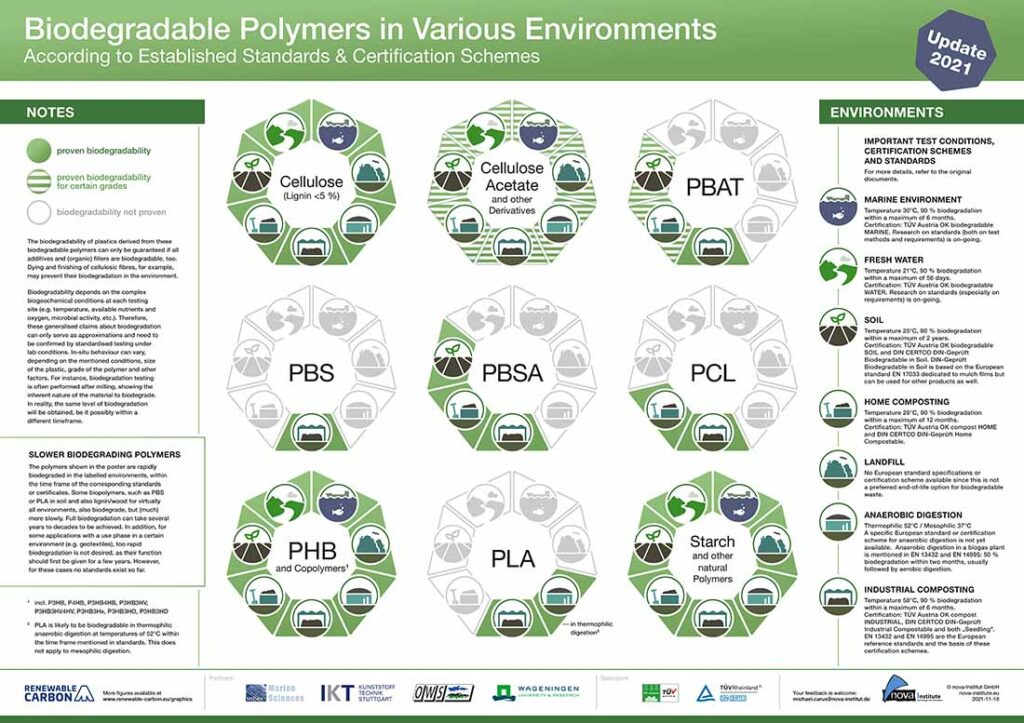
In determining outcomes, we should define the problem we are working to solve. The microplastics waste stream issue isn’t solved by simply putting an end to littering. The complex issue demands a multi-front tactic from a global perspective on waste management, consumer habits, regulations, chemicals of concern, etc. We did not get in the current crisis overnight, and it cannot be solved by in fell swoop – but we must start somewhere.
A “circular economy’ is touted as being the ultimate solution. On a global scale, this is very aspirational due to the required infrastructure and time required. Every year the problem gets worse; but what can we do today? Even with a robust recycling system today, there would still be leakage. Key material solutions that address the issue are shown in Figure 1.
To effectively address the plastic issue, it will take numerous solution pathways. Before we develop and implement alternate material solutions, we can at least minimize plastic in our products.
In fact, over the last couple of decades, nonwoven producers have taken mass out of products through more efficient production of nonwovens. For example, spunbonded fabrics produced today are made of much finer fibers which provides more coverage and tensile strength. This enables producers to provide the required material specifications with lighter weight materials.
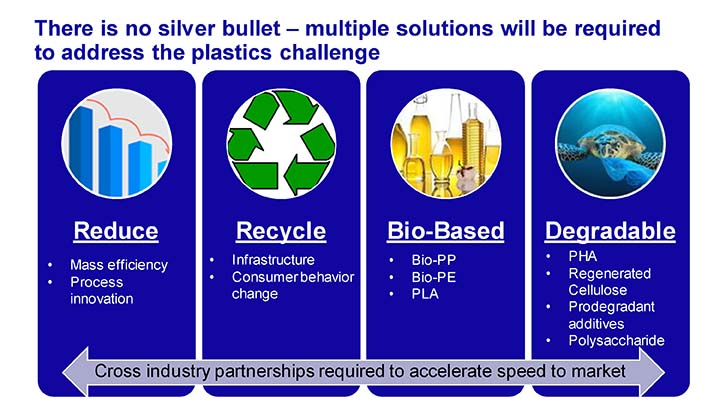
The nonwoven industry is tuned for polypropylene. Should we invest in existing technology to reduce mass or new technologies to process biodegradable polymers? To advance quickly, we need biodegradable solutions. The good news is much of the technology that has been developed to process polypropylene more effectively can be used to help with processing alternate resins.
Recycling is an obvious solution, yet is has its own set of issues, such as water management, including collection and contamination. Advanced or chemical recycling has a lot of advantages, like the ability to recycle products comprised of many components without the need for separation. This may be an excellent bridge solution while we are still predominately use petrochemical-based polymers. Yet, it should be mentioned – again – that over the past 70 years we have only recycled 9% of all plastic produced.
Biobased polymers can reduce our dependency on petroleum; however, if these materials are not biodegradable, we are not really addressing the problem. Figure 2 shows the level of biodegradation for various materials.
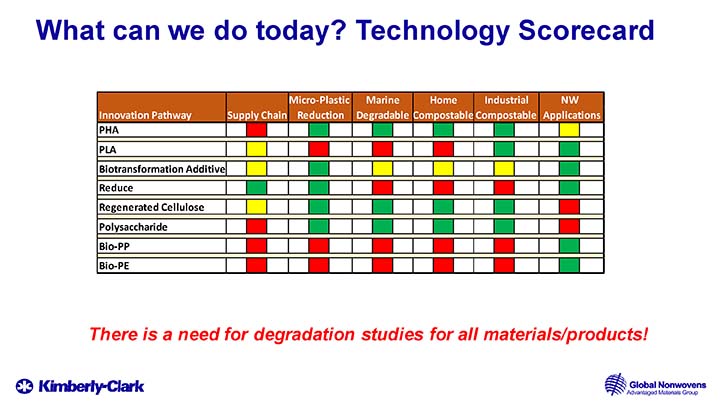
Marine degradability is the high bar and only a few synthetic fibers can achieve this including PHA, viscose and lyocell. Unfortunately, these materials can’t be processed on existing nonwoven machines. PHA and PLA, for instance, can be processed on existing assets. PHA is known for its ability to degrade in a marine environment. More recently a study was published that indicated PLA does not result in persistent microplastics in a marine environment14. It would be very beneficial for the market if companies could make a plastic-free claim when incorporating these marine degradable resins into their products. In the eventuality these materials did leak into the environment at least they would biodegrade and not result in microplastics.
Due to their desirable end-of-life properties, these materials are being considered as alternatives. PHA, for instance, has been around for some time but due to high costs and lack of supply chain it has not been incorporated into high volume applications, like wipes and hygiene products. Fortunately, there are numerous suppliers working on solutions including RWDC, Danimer Scientific, Mango, Newlight, CJ Biomaterials, and Kaneka to name a few. The reality of the situation is there will need to be a significant investment of capital to install capacity to supply the growing markets; this could realistically take decades. In the meantime, there are other materials like PLA that can play a significant part in the solution due to existing supply.
A Smelly Situation – with Hope
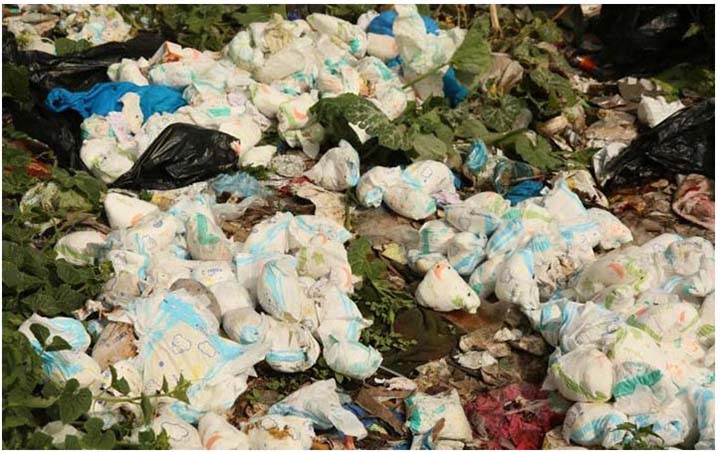
Every minute, more than 300,000 disposable diapers around the world are incinerated, sent to landfill, or pollute the environmen15. If we could instantly make diapers out of biodegradable materials today, would we solve the problem or make things worse? It turns out that if we start disposing more biodegradable materials into landfills, we will in fact produce more methane due to biodegradation in an anaerobic environment. Methane is a potent greenhouse gas that has more than 80 times the warming power of carbon dioxide over the first 20 years after it reaches the atmosphere.
Even though CO2 has a longer-lasting effect, methane sets the pace for warming in the near term16. A better way to handle these biodegradable materials is through industrial composting. Composting is simpler than recycling in that more complex products would not need to be broken down like advance recycling. Furthermore, the compost can be used to produce the feedstock for biopolymer production, see the circular carbon cycle for PHA.
I am encouraged by all the industry activity and focus to develop the products solutions and supply chains for alternate polymers like PHA. Many suppliers have plans to install more capacity. The larger issue is the demand for substitute polymers is now, not later. For the previous example of the diaper market, we would need 400 25kT plants to supply the nonwovens for only one product category. Realistically, it will take time to develop the solutions and supply chains for these alternate materials. With the criticality of the problems to solve and potential impacts on humanity, we must fast-track efforts to effectively address the situation.

Coopetition – Are You with Us?
Based on the dire circumstances presented in images, scientific data, and our collective personal observations, it is clearly apparent that we are in a precarious situation as an industry. There is no immediate solution. I argue that unless our industry works together more effectively, we may be ineffective in developing viable solutions. Furthermore, it will require cooperation between our industry and governments, as well.
Regulation will play a key role on testing standards and evaluating impacts on the environment and health. In an ideal situation of cooperation, companies would seamlessly share data in order to develop solutions faster. The coopetition across the industry is more for the thriving of humanity versus achieving corporate imposed quarterly earnings.
Consider this a call to industry to drop the corporate veil and operate more openly to solve the problem. The question at hand is: Will you join us in this cause?
Reach out today INDA to join the conversation on sustainability.
References:
- https://environment.ec.europa.eu/topics/plastics/single-use-plastics_en
- https://www.un.org/en/climatechange/nations-agree-end-plastic-pollution
- https://marinedebris.noaa.gov/why-marine-debris-problem/ingestion
- https://newmaterials.uga.edu/what-is-plasticosis-is-it-a-ticking-time-bomb-for-human-and-animal-health/
- https://www.sciencedirect.com/science/article/pii/S0160412020322297
- https://www.sciencenews.org/article/microplastics-nanoplastics-heart-attacks-strokes-health
- https://www.latimes.com/environment/story/2024-01-18/health-costs-of-plastics-run-250-billion-a-year
- https://www.genevaenvironmentnetwork.org/resources/updates/plastics-and-climate/
- https://www.kimberly-clark.com/en-us/company/supplier-link/standards-and-requirements/social-compliance/sustainability-policies and https://www.kimberly-clark.com/en-us/esg/2030-ambition
- https://www.kimberly-clark.com/en-us/esg/2030-ambition/esg-article/product-packaging-circular-systems
- https://environment.ec.europa.eu/topics/plastics/biobased-biodegradable-and-compostable-plastics_en
- https://www.unep.org/inc-plastic-pollution
- https://www.oecd.org/en/about/news/press-releases/2022/06/global-plastic-waste-set-to-almost-triple-by-2060.html
- https://www.nature.com/articles/s41428-020-00396-5
- https://www.weforum.org/agenda/2023/08/disposable-nappies-landfill-plastic-circular-economy/
- https://www.edf.org/climate/methane-crucial-opportunity-climate-fight


